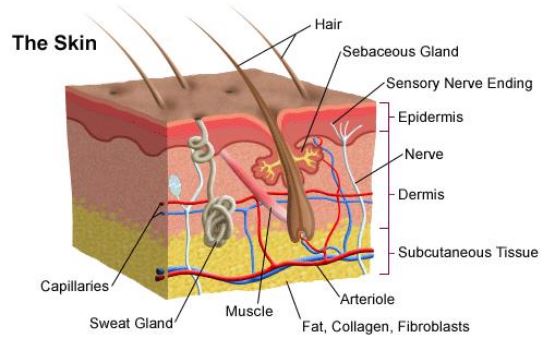The Science of Skin – Interesting Facts about Skin

The Science of Skin – Interesting Facts about Skin
Skin actually has 3 layers- epidermis, dermis and the subcutaneous fat. The epidermis is the skin that we can see; In the dermis, there are nerves and blood vessels. Subcutaneous fat protects bones and organs that’s why we need fats. Our skin colour depends on Melanin. Skin performs various roles like- protect us from various harmful things. It stops water from going inside our skin helps us maintaining right temperature or adjusts our body comfortably with the temperature whether it’s too hot or too cold. Skin accounts for about 16% of the person’s total body weight but it varies totally depend on an individual.
This must not be new for you. The skin we all people know what skin is it? Skin is the uppermost layer of the body that covers our whole body like a shield. Skins are of various colours- white, brown, tan, beige, pink, dark, and medium, fair, light or pale etc. There are many skin colours.
What else do you know? Where these colours come from? How much percentage is occupied in our body by the skin? What is its role? What is inside the skin or you can say the whole story of skin? Do you know these questions answers? If your answer is no and you are also curious to know all the matter related to skin, then my friend this article is completely for you.
Let’s begin our journey –
Skin is stretchable. How? Pull your cheeks. Yes it’s a proof skin is stretchable and it’s waterproof too. It covers our whole body like a bag covers our whole stuff inside pencils, notebook, Tiffin etc. It protects us from germs, water, and sunshine and also helps in keeping our body’s temperature right.
Contents
Skin Anatomy : How skin works?
Our skin has three layers. 1st one is epidermis and the 2nd one is dermis and 3rd is subcutaneous fat. The epidermis is that skin which one can see or it’s the upper layer of skin visible to our eyes underneath epidermis there is dermis second layer of skin which we can’t see. In the dermis, there are nerves and blood vessels. The epidermis contains skin melanin. Subcutaneous fat protects bones and organs that’s why we need fats. Hair follicle starts from down here and goes way up to epidermis.

For understanding more clearly how skin works you can watch this video.
How much percentage is occupied in our body by the skin?
The thickness of our skin varies throughout our body. Like the pads on your feet are as thick as pencil eraser but the thickness around your eyes are just like few sheets of paper only. Skin includes hair as well as nails, it means it’s all not fleshy. Skin accounts for about 16% of the person’s total body weight. Skin weight totally depends on an individual, skinnier people normally weigh less than heavier ones.
What is the role of skin?
Skin perform various functions like a house gate it protect us from various harmful things. It stops water from going inside our body like when you go swimming or take a shower. When you soak yourselves in water or spend more than excessive time in water then the topmost layer of skin called epidermis gets waterlogged and rinky.
Our skin helps us maintaining right temperature or adjusts our body comfortably with the temperature whether it’s too hot or too cold. Blood vessels, hair and sweat glands cooperate to keep our body adjustable with the temperature.
What is skin made of?
Have you ever heard of melanin? If no then we are going to tell you about this as this is the most important substance affecting our skin colour. Melanin is like a natural sunscreen. The more melanin the darker you will be. When a person is outside in the sun the body produces extra melanin to protect our skin from harsh rays coming from the sun. In very cold or chilled places with little sunlight, the skin does not need much melanin to protect itself which is why you might have seen that people coming from hot countries are dark in colour whereas people coming from cold countries are fairer. Melanin is the reason why a person gets tan or burn.
Some facts about skin
- Skin is the largest organ in the body
- Skin plays a very crucial role in maintaining our body temperature.
- Skin regenerates itself. Every 28 days it renews itself mindblowingly.
- Bacteria in millions live on the skin.
- The average skin when stretched out is 2 square meters.
- There are two types of skin- hairy and glabrous.
- Eyelids have the thinnest skin.
- Over 50% of the dust in our home is actually dead skin.
For healthy skin you need to –
Consumption of tomatoes, carrots, kale, walnuts, 0ranges, Cocoa, yoghurt, fruits and vegetables, tofu, milk etc. there are many other things that gives you flawless skin and the most important keep your body hydrated by drinking required litres of water in a day that varies from person to person and gender. Water is also considered best for having flawless skin.






Responses